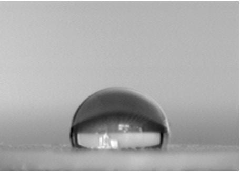Method for preparing amphiphobic wood/calcium carbonate composite material by biomimetic mineralization in-situ process
An in-situ preparation and biomimetic mineralization technology, applied in the direction of wood impregnation, impregnated wood, wood processing equipment, etc., can solve the problems of high energy consumption and increased cost of composite materials, and achieve low energy consumption, low cost, and improved mechanical strength Effect
- Summary
- Abstract
- Description
- Claims
- Application Information
AI Technical Summary
Problems solved by technology
Method used
Image
Examples
specific Embodiment approach 1
[0011] Specific Embodiment 1: The method for preparing amphiphobic wood / calcium carbonate composite material in situ by the biomimetic mineralization method of this embodiment is carried out according to the following steps: 1. Calcium chloride solution with a concentration of 0.1mol / L to 2mol / L is prepared Two, prepare the alcohol solution of the organic amphoteric surfactant, wherein the organic amphoteric surfactant in the alcohol solution: the mass ratio of alcohol is 1:1~100; The alcohol solution of the prepared organic amphoteric surfactant is mixed, wherein the mass ratio of calcium chloride:organic amphoteric surfactant is 1:0.01~0.5, and stirred at 10℃~60℃ for 0.5h~3h to obtain the mixed solution; four, immerse the wood material in the mixed solution obtained in step three for 0.5 to 10 days; five, immerse the wood treated in step four in a sodium carbonate solution with a concentration of 0.1mol / L to 2mol / L impregnated until the mass increase rate of the wood was ≤4%...
specific Embodiment approach 2
[0013] Specific embodiment two: the difference between this embodiment and specific embodiment one is: the organic amphoteric surfactant described in step 2 is betaine type amphoteric surfactant, imidazoline type amphoteric surfactant, aminopropionic acid type amphoteric surfactant active agent or taurine-type amphoteric surfactant. Others are the same as in the first embodiment.
specific Embodiment approach 3
[0014] Embodiment 3: The difference between this embodiment and Embodiment 1 or 2 is that the alcohol described in step 2 is ethanol or methanol. Others are the same as in the first or second embodiment.
PUM
| Property | Measurement | Unit |
|---|---|---|
| elastic modulus | aaaaa | aaaaa |
| compressive strength | aaaaa | aaaaa |
| elastic modulus | aaaaa | aaaaa |
Abstract
Description
Claims
Application Information
 Login to View More
Login to View More - R&D
- Intellectual Property
- Life Sciences
- Materials
- Tech Scout
- Unparalleled Data Quality
- Higher Quality Content
- 60% Fewer Hallucinations
Browse by: Latest US Patents, China's latest patents, Technical Efficacy Thesaurus, Application Domain, Technology Topic, Popular Technical Reports.
© 2025 PatSnap. All rights reserved.Legal|Privacy policy|Modern Slavery Act Transparency Statement|Sitemap|About US| Contact US: help@patsnap.com


